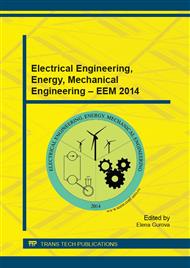p.181
p.188
p.193
p.199
p.203
p.209
p.215
p.222
p.226
Problem Oriented Simulation of Heating Stage in Technological Chain for Metal Hot Forming
Abstract:
Most high duty parts used in various fields of productions are forged parts made of steel. The conventional forging process chains include an induction heating systems and hot forming equipment. The large amount of consumed energy and an excess of material (flash) are the main factors motivating necessity to optimize the industrial technologies of metal hot forming. A significant economical effect can be achieved through optimization of heating modes and design parameters of induction heaters on the basis of modern optimal control theory for distributed parameters systems. The aim of the presented research is a problem-oriented simulation of induction heating stage in the forging chain. 2D ANSYS model provides FEM analysis of interrelated electromagnetic, temperature and thermal stress fields during induction heating of a steel cylindrical billet before its hot forming. The model has interface adapted to optimization procedures; it provides more options for variation of the heating system parameters or billet geometry and material properties, and for evaluating the process optimization abilities.
Info:
Periodical:
Pages:
203-208
Citation:
Online since:
December 2014
Authors:
Price:
Сopyright:
© 2015 Trans Tech Publications Ltd. All Rights Reserved
Share:
Citation:


